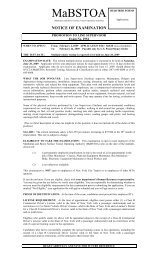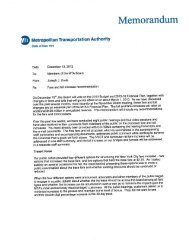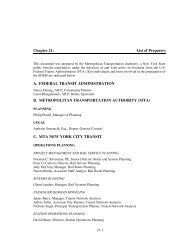Greening Mass Transit & Metro Regions: The Final Report - MTA
Greening Mass Transit & Metro Regions: The Final Report - MTA
Greening Mass Transit & Metro Regions: The Final Report - MTA
Create successful ePaper yourself
Turn your PDF publications into a flip-book with our unique Google optimized e-Paper software.
Energy/Carbon<br />
Energy use, fuel consumption, emissions and CO2 avoidance<br />
For policymakers worldwide, climate change is now an<br />
established fact demanding concerted action. Already, data<br />
indicate a closing window of opportunity if we are to forestall<br />
the worst environmental and economic effects of global<br />
warming. Against this backdrop, the <strong>MTA</strong> offers a working<br />
model of high-value infrastructure for a low-carbon economy.<br />
<strong>The</strong> <strong>MTA</strong> system provides the rapid mobility essential to<br />
a prosperous economy while reducing fossil fuel consumption.<br />
As a result, the <strong>MTA</strong> region enjoys one of the highest<br />
rates of economic productivity and lowest rates of energy<br />
consumption in the world. <strong>The</strong> <strong>MTA</strong> system demonstrates<br />
how investment can mitigate global warming while sustaining<br />
economic growth.<br />
<strong>The</strong> Commission looked at innovative ways to further<br />
improve the <strong>MTA</strong> system’s carbon efficiency. <strong>The</strong> resulting<br />
recommendations fall into two categories. <strong>The</strong> first is integral<br />
to the <strong>MTA</strong>’s mission as the nation’s largest public transit<br />
system. With every extension of its transit operations, the<br />
<strong>MTA</strong> system takes tens of thousands of additional drivers<br />
off the roads (typically on a permanent commuting basis),<br />
transporting them instead on fuel-efficient subways, trains,<br />
and clean-technology buses – thus reducing oil consumption<br />
and CO2 output. A slight increase in transit carbon output<br />
typically signals an exponentially higher increase in carbon<br />
avoidance. In other words, growing the <strong>MTA</strong>’s carbon<br />
footprint actually shrinks the region’s net carbon footprint.<br />
Having assumed an even greater global urgency, this traditional<br />
mission will continue to be the <strong>MTA</strong>’s foremost contribution<br />
to sustainability. Quantifying this regional benefit<br />
should provide new ways to identify and evaluate funds or<br />
resources for the <strong>MTA</strong>. <strong>The</strong> Commission’s recommendations<br />
for expanding <strong>MTA</strong> transit access region-wide are addressed<br />
primarily in the Smart-Growth/TOD and Strategy for the<br />
21st Century: Legislative and Policy Recommendations<br />
chapters of this report.<br />
Total Regional GHG Emissions<br />
<strong>Mass</strong><br />
<strong>Transit</strong><br />
Other<br />
Transportation<br />
<strong>Mass</strong><br />
<strong>Transit</strong><br />
Other<br />
Transportation<br />
Less <strong>Mass</strong> <strong>Transit</strong> More <strong>Mass</strong> <strong>Transit</strong><br />
A small increase in transit’s carbon footprint typically delivers<br />
an exponentially greater decrease in the region’s carbon<br />
footprint, resulting in substantial net carbon avoidance.<br />
Source: T. Papandreau, LA <strong>Metro</strong><br />
<strong>The</strong> second category, the main focus of this chapter,<br />
concerns energy and carbon reductions within the <strong>MTA</strong><br />
system itself. <strong>The</strong> <strong>MTA</strong> has a history of pioneering cleaner,<br />
more efficient energy consumption at every level of operations,<br />
from the nation’s largest all-CNG bus fleet at Long Island<br />
Bus to innovations in track design and green architecture.<br />
<strong>The</strong> sustainability gains show up in a number of statistics.<br />
For example, the <strong>MTA</strong> accounts for 65 percent of all New<br />
York City commutes while using just 5 percent of New York<br />
City’s total energy consumption. Likewise, the fact that New<br />
Yorkers consume one quarter as much energy per capita as<br />
the average American is largely attributable to the <strong>MTA</strong><br />
system. In other words, if the entire nation matched the<br />
energy/carbon profile of the <strong>MTA</strong>’s transit radius, we would<br />
cut foreign oil dependency dramatically and achieve the<br />
Kyoto Protocol carbon emission targets decades ahead<br />
of schedule.<br />
<strong>The</strong> Commission looked at energy/carbon solutions in<br />
all areas of operations, as outlined below. Since no single<br />
initiative can radically alter the <strong>MTA</strong>’s current energy consumption,<br />
the recommendations focus on a combination of<br />
traditional efficiency programs and strategic investments in<br />
new energy technologies. Several programs deserve special<br />
mention. <strong>The</strong> first involves energy retrofits of <strong>MTA</strong> facilities<br />
in conjunction with the New York Power Authority (NYPA),<br />
an ongoing program that is projected to save greater than<br />
78,000 megawatt hours of electricity and 123,000 gallons<br />
of diesel fuel per year by 2010. Related upgrades to energyefficient<br />
lighting throughout the system include compact<br />
fluorescent light bulbs (CFL) in subway tunnels and lightemitting<br />
diode (LED) lighting for the Verrazano Narrows<br />
Bridge, one of the first LED lighting systems installed on<br />
any major U.S. span. <strong>The</strong> second program of particular note<br />
involves the development and piloting of green technology<br />
initiatives, including the use of energy generated by solar<br />
panels and tidal turbines, as well as testing of energy storage<br />
technologies and researching wind energy potential on <strong>MTA</strong><br />
facilities and corridors. <strong>Final</strong>ly, to help obtain 80 percent of<br />
the <strong>MTA</strong> electrical power from green sources by 2050, the<br />
<strong>MTA</strong> should join forces with NYPA and others to develop<br />
the vast potential of offshore wind power. If carried out as<br />
recommended, this transformational clean-energy initiative<br />
would completely alter the energy/carbon profile of the<br />
<strong>MTA</strong> and its service area. Since energy/carbon reductions<br />
are a primary goal of all sustainability programs, additional<br />
initiatives can be found under the Facilities chapter and the<br />
other sections of this report.<br />
17
















